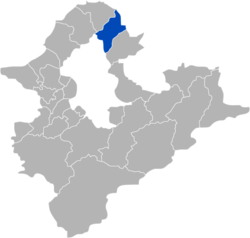Jinshan District, New Taipei
Jinshan
金山區 Kanayama | |
|---|---|
| Jinshan District | |
 | |
 Jinshan District in New Taipei City | |
| Coordinates: 25°14′10″N 121°37′03″E / 25.23611°N 121.61750°E | |
| Country | Republic of China (Taiwan) |
| Region | Northern Taiwan |
| Special municipality | New Taipei City (新北市) |
| Area | |
| • Total | 49.21 km2 (19.00 sq mi) |
| Population (January 2016) | |
| • Total | 22,273 |
| Time zone | UTC+8 (CST) |
| Postal code | 208 |
| Website | http://www.jinshan.ntpc.gov.tw |
| Jinshan District | |||||||||||||||||||
|---|---|---|---|---|---|---|---|---|---|---|---|---|---|---|---|---|---|---|---|
| Chinese | 金山區 | ||||||||||||||||||
| Literal meaning | Golden Mountain | ||||||||||||||||||
| |||||||||||||||||||

Jinshan District (Chinese: 金山區) is a rural district on the coast in northern New Taipei, Taiwan. The district draws many visitors each year because of its hot springs and its proximity to Chin Pao San and the Ju Ming Museum. The district is home to the Dharma Drum Buddhist College, an institution of higher learning founded by Dharma Drum Mountain monastics devoted to the principles of Zen Buddhism.[1]
Name Origin
This area was originally a Ketagalan settlement, called "Ki-ppare" (Basay: Quimourije),[2] meaning "bumper harvest". This was later adapted as Kimpauli (金包里; Pe̍h-ōe-jī: Kim-pau-lí), the choice of characters perhaps influenced by the discovery of golden dust in the Sulfur creeks.[3] In 1920 during Japanese rule, the area was renamed Kanayama Village (金山庄), Kīrun District (基隆郡), Taihoku Prefecture.
Geography
- Area: 49.21 km2
- Population: 22,400 people (2014)
Education
Tourist attractions
Notable natives
- Lee Hong-chi, actor
See also
References
- ^ "Dharma Drum University". Ddc.edu.tw. Archived from the original on 2013-09-21. Retrieved 2014-04-23.
- ^ 翁佳音 (1998). 大台北古地圖考釋 (in Chinese). Taipei: 台北縣立文化中心. ISBN 9789570220841.
- ^ 李世榮; 吳立萍 (2003). 台灣的老鄉鎮 (in Chinese). Xindian: 遠足文化事業股份有限公司. pp. 22-25. ISBN 957280314X.
External links
- Jinshan District Office, New Taipei City (in Chinese)
